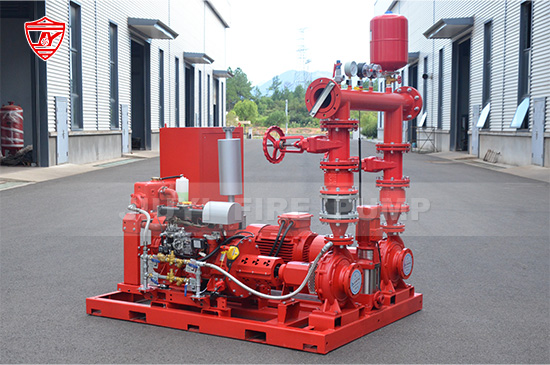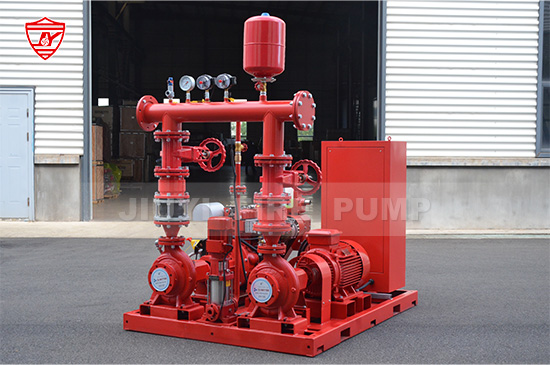Accurate data recording during fire pump testing is one of the most critical aspects of maintaining a reliable fire protection system. Fire pumps are the heart of any fire suppression system, ensuring adequate water pressure and flow during an emergency. However, even the most advanced fire pump is only as dependable as its maintenance and testing practices. This article explains how to record fire pump test data accurately, interpret results effectively, and ensure compliance with standards such as NFPA 25.

Recording fire pump test data is not merely a procedural requirement—it’s an essential step in verifying that the system performs as designed. Inaccurate data can lead to misinterpretations, false assumptions about pump performance, and non-compliance with fire safety regulations.
Ensures NFPA 25 compliance – NFPA 25 requires documented evidence of fire pump performance during regular testing. Inaccurate or incomplete records can result in code violations.
Prevents costly downtime – Reliable data helps identify performance decline early, preventing unexpected failures.
Assists in trend analysis – Consistent data allows engineers to track pump efficiency and identify degradation over time.
Supports insurance and inspection audits – Properly recorded data serves as official documentation for insurers, fire marshals, and safety inspectors.
The NFPA 25 Standard for the Inspection, Testing, and Maintenance of Water-Based Fire Protection Systems outlines specific testing frequencies and documentation procedures.
The two most common tests include:
Annual Flow Test – A full performance test that measures pump pressure and flow across multiple points (churn, rated, and 150% capacity).
Weekly or Monthly Test Runs – Operates the pump to ensure readiness, verify automatic start functions, and check for leaks or unusual noises.
For both types of tests, detailed data recording is essential.
To record accurate fire pump test data, it’s important to use reliable instruments that are properly calibrated. The following equipment is commonly used during fire pump performance tests:
Pressure gauges – Measure suction and discharge pressures at each flow point.
Flow meters or pitot gauges – Determine flow rates through test headers or flow meters.
Tachometer – Monitors pump speed (rpm), especially important for diesel engine fire pumps.
Voltmeters and ammeters – For electric fire pumps, measure voltage and current to check electrical load.
Thermometers – Record engine temperature, cooling water, and bearing temperatures (for diesel-driven units).
Timer or stopwatch – Ensure accurate measurement of start-up time and test duration.
All measuring devices should be calibrated annually and verified before each test to avoid inaccurate readings.
Preparation is key to ensuring accurate data. Confirm that:
Gauges are in good condition and properly zeroed.
Test meters are clean and free of obstructions.
Valves and flow lines are correctly configured for the test.
The test header and discharge lines are clear.
It’s also important to review previous test data so you can compare results and detect changes in performance.
Environmental factors can influence fire pump performance. Record:
Ambient temperature
Barometric pressure (if available)
Suction water source temperature and level
These details help normalize data when comparing performance year over year.
Start the fire pump and let it run at churn (no flow). Record:
Discharge pressure
Suction pressure
Engine speed (rpm)
Electrical readings (voltage, current)
This baseline establishes how the pump performs when running without demand and helps identify pressure relief or packing issues.
Conduct the flow test at three flow rates:
Churn (0%)
Rated flow (100%)
150% of rated capacity (maximum test point)
At each point, document:
Suction pressure (psi or bar)
Discharge pressure (psi or bar)
Flow rate (gpm or L/min)
Pump speed (rpm)
Voltage and amperage (for electric pumps)
Engine temperature and oil pressure (for diesel pumps)
Compare the data with the manufacturer’s certified performance curve. A deviation greater than 5% may indicate wear, blockage, or impeller issues.
Beyond numerical data, qualitative observations are also crucial. Record:
Any unusual noise or vibration
Cavitation or water hammer
Leaks at seals or valves
Engine starting behavior (time to start, smoke, etc.)
Electrical issues such as voltage drops or overheating
These notes provide context that numbers alone cannot capture and can help diagnose future performance issues.
After testing, record:
Final suction and discharge pressures after shutdown
Time required for the pump to stop
Battery voltage (for diesel engines)
Condition of couplings, bearings, and alignment
Lubrication or cooling system performance
A brief summary of the overall system condition should also be included in the test report.
Consistency is key. Always use a standardized test sheet or digital form that includes fields for all relevant data points. This helps avoid missing information and simplifies future comparisons.
Have a second technician verify data readings during and after the test. Cross-verification eliminates transcription or interpretation errors.
All measuring instruments should be traceable to national calibration standards. Record the calibration date and certificate number on the test sheet.
Avoid writing data later from memory or notes. Real-time recording ensures precision and reduces the chance of errors caused by delayed entry.
Digital storage offers several advantages over paper-based systems. Use an electronic fire pump test log or maintenance management software to archive results, generate trends, and issue automatic reminders for the next test.
Inconsistent units of measurement – Mixing psi and bar, or gpm and L/min, can cause confusion and misinterpretation. Stick to one system consistently.
Neglecting suction readings – Many operators record only discharge pressure, missing vital performance indicators.
Failing to note environmental conditions – Temperature and altitude can affect readings; always document them.
Skipping verification of flow meters – A miscalibrated meter can mislead the entire report.
Not comparing with previous results – Trends are more important than single data points.
Avoiding these mistakes ensures your fire pump test records remain accurate and defensible during audits or inspections.
Once data is recorded, compare it to:
The pump’s original certified curve
Previous annual test data
If the flow or pressure at rated capacity falls by more than 5% from previous results, investigate the following possible causes:
Impeller wear or scaling
Blocked suction or discharge piping
Motor or engine speed drop
Air leaks on the suction side
Incorrect test setup
Document corrective actions in the same report to maintain a clear maintenance history.
Although some facilities conduct in-house tests, involving a qualified fire pump professional or manufacturer-certified technician ensures test validity and compliance. A professional can:
Verify test setup accuracy
Interpret performance trends
Recommend maintenance or repair actions
Ensure documentation aligns with NFPA 25 and local authority requirements
Partnering with an experienced fire pump manufacturer or service provider guarantees both technical accuracy and long-term reliability.

Accurate fire pump test data recording is not just a regulatory requirement—it’s a key component of a dependable fire protection strategy. Every detail, from properly calibrated gauges to standardized reporting, contributes to ensuring that your fire pump performs when it matters most.
By following a consistent, detail-oriented process aligned with NFPA 25, facility managers and safety engineers can maintain compliance, identify issues early, and ensure continuous protection for people and property.